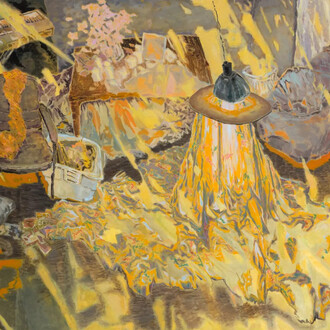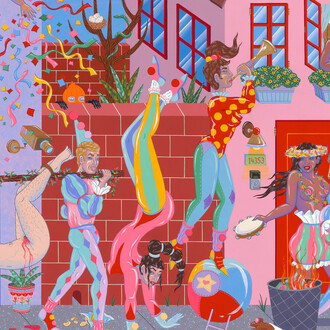Francesca Longhini’s artistic practice is seeded in her dynamic and complex investigation into the inaccuracies, decompositions, and reinterpretations of color and poetry.
Longhini admiration of Italian masters, in particular, Caravaggio and Titian is the starting point of her work. However, Longhini saw no future in their visual vocabulary. She not only considers the opulence and richness of baroque as a style, but also imagines it as a state of mind, which is often confused and muddled. In an attempt to create order and spur artistic evolution, Longhini employs control in the form of a reduced palette and steady composition. Wielding this restricted natural palette of chromium oxide green, white, and graphite, Longhini explores an elegant language of stripes, points, and lines on linen and cotton canvas. Within these compositions, small hints of gold, historically considered a holy color and spiritual material, suggest a symbolic light that harkens back and pays homage to the gilded paintings of the Italian Baroque.
Longhini most recent works can be thought of as powerless or anesthetized, indifferent spectators. They seek their personal balance inside a scenario where images and hierarchies of sense and meaning are mixed up without any criterion, where the goal is to take advantage of the social media users.
The marbling effect is obtained with a technique called Turkish Ebru. The effect is not created directly on canvas; it is obtained on a support filled with water, where the color is laid and worked carefully to reach the result. Only afterwards is the canvas laid on the liquid surface, “face down”, and “impressed” with the marbled design. The gold foil are placed afterwards, in a classic manner.
If Longhini’s previous artworks were tied to dynamics among many elements or individuals, her 2019 works are clearly tied to the individual’s analysis. The marbling effect itself suggests a psychologic dimension, able to become the metaphor of an inner place, which is as unstable and continuously changing as the water the artist uses in her painting process.
Is there anything more terrifying than beauty itself? I have selected some existing source images. Some of them are beautiful, others are ugly, others are stupid, and others are even gross and horrible for what they mean. I have put them all on the same level because I have painted them without control and aiming to make them look beautiful and golden. On the marbled surface, the glue becomes invisible a few seconds after it is spread. Controlling the composition of the image is not an option anymore. The outcome is out of my control. The gold foil sticks to the glue and finally unveils the image. The hierarchy of sense is flattened. Like in our daily social media feed bombing, the remarkable and the trivial live in the same Home. The scrolling waterfall blinds us in front of what is shocking, hateful, horrifying or lovable. Everything is glossy, so far away from us and we feel so comfortable, so safe in our golden anesthesia. In this scenario, those who are not willing to subside to the anesthesia, stand like defenseless spectators, lost in the small, precarious, stumbling balances of their anxious existence. Is there anything more terrifying than beauty itself? “
(Francesca Longhini, May 2019.)
Francesca Longhini was born in 1985 in Brescia, Italy where she currently lives and works. Recent exhibitions include Baroque Anxiety at Ibid Gallery in Los Angeles (2017), Blunder at Loom Gallery in Milan (2017), Notre avenir est dans l’air at Antiquarium Alda Levi in Milan (2015), Studi ApertiXI EdizioneSocial Utopia at Tornielli Museum in Ameno, Novara, Italy (2015) and The Intruders at Jewish Museum of Venice (2015).
















